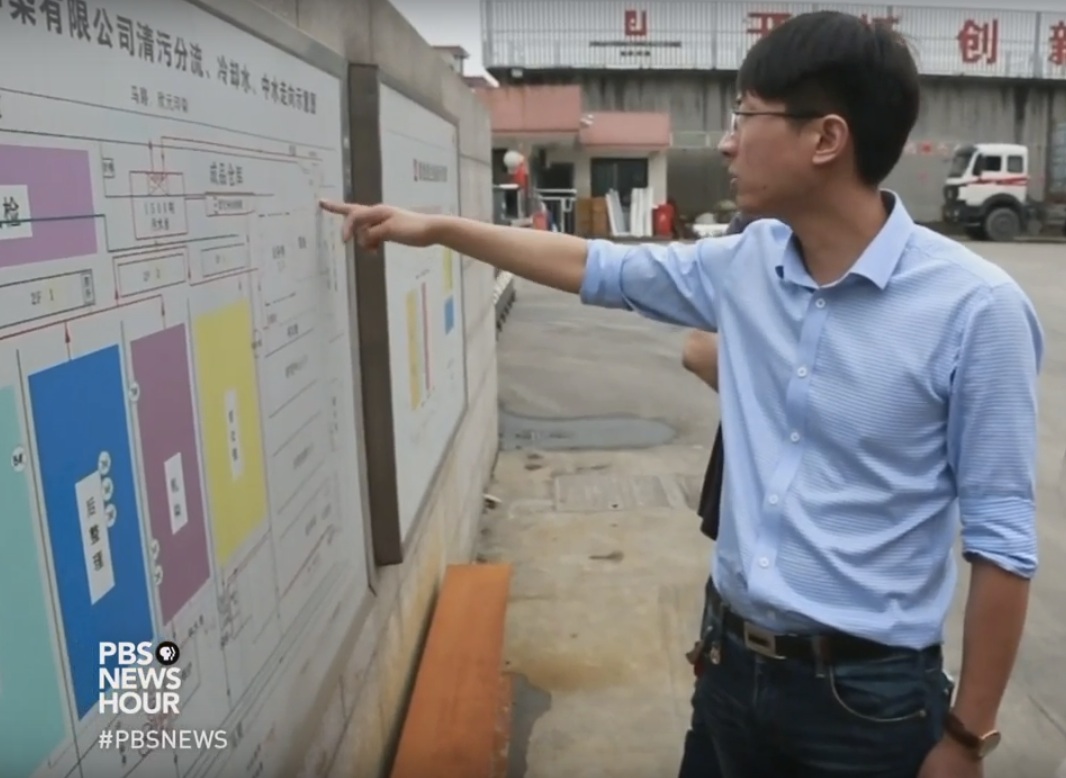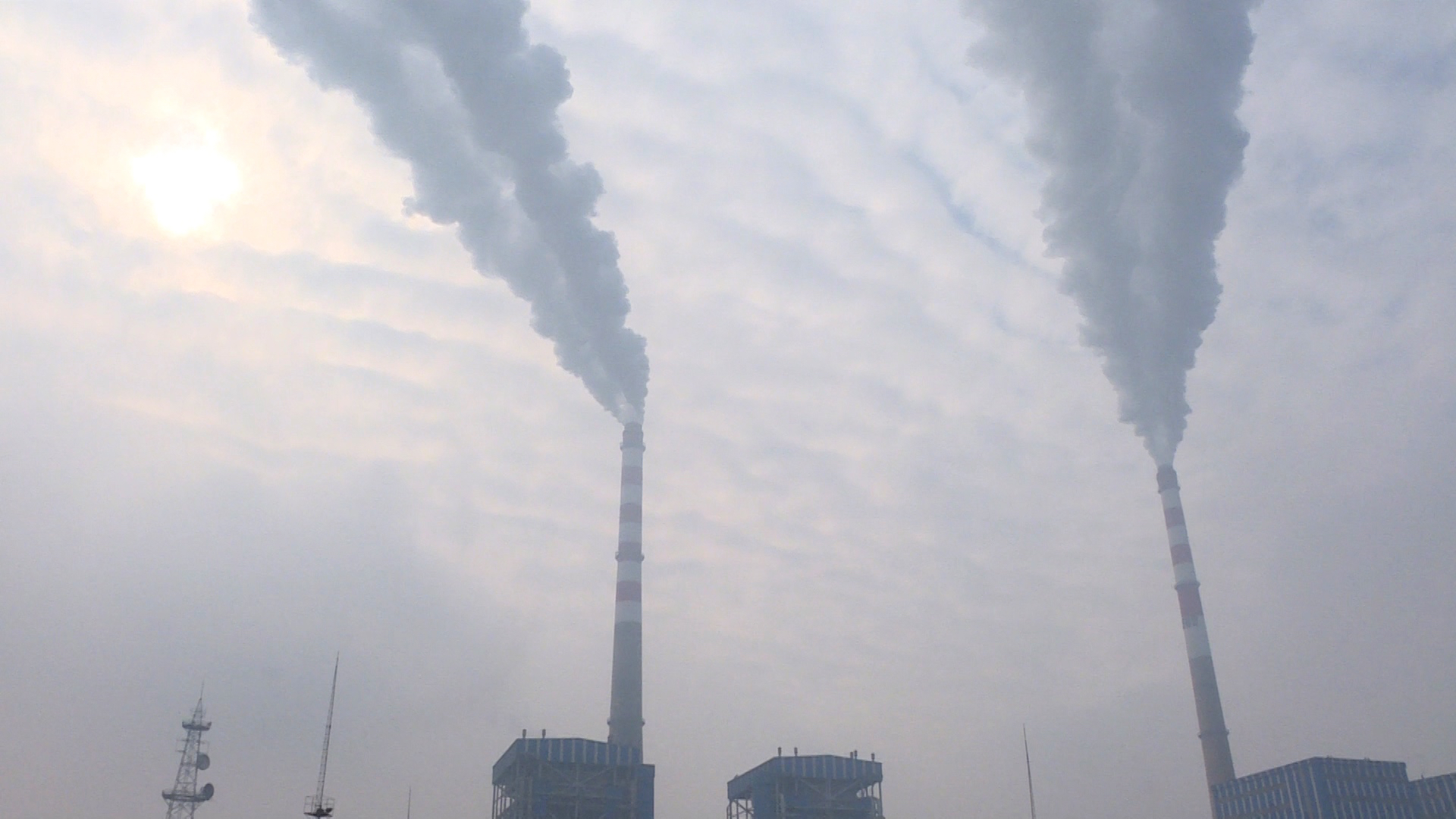
GWEN IFILL: As thick smog bore down on China's capital today, Beijing issued its first-ever red alert. The country's highest possible warning prompted citywide school closings and driving restrictions.
The scenes are a stark reminder of the huge environmental price China has paid for becoming the world's factory, a problem experts say the government is now taking seriously.
One gauge of that is the free rein given to a non-government environmental group.
Fred de Sam Lazaro reports from China as a part of his ongoing series Agents for Change.
FRED DE SAM LAZARO: The inspectors came calling recently at this massive textile factory in the eastern city of Hangzhou. The plant is part of the Saintyear company, one of the icons of China's rapid rise as a manufacturing powerhouse. It produces two billion feet of patterned and dyed fabric each year for clothing makers and retailers around the world.
This plant also produces some 60,000 tons of waste water, and a 2013 investigation found it wasn't being adequately treated.
Manager Wang Wei said millions of dollars were invested to upgrade the system.
WANG WEI, Vice President, Saintyear (through interpreter): Today, we invited IPE in to show them our changes, our improvement in environmental protection, so their inspectors can see we are in compliance with government requirements.
FRED DE SAM LAZARO: But IPE, the inspectors, are not from the all-powerful government. The Institute of Public and Environmental Affairs, is a small non-government organization.
IPE founder Ma Jun has won international awards for his environmental activism, with no apparent objection from the government. He's used technology and political savvy to take on China's powerful industrial establishment, says Linda Greer of the Washington-based NRDC, the Natural Resources Defense Council, which has partnered with IPE.
LINDA GREER, Natural Resources Defense Council: I think he's an astute observer of what are the problems and how can they best be solved in China.
FRED DE SAM LAZARO: Ma was an investigative journalist in the 1990s, when he began documenting the toll of China's industrialization, environmental and human.
MA JUN, Founder, Institute of Public and Environmental Affairs: Like in those cancer village, a group of old ladies kneeling down in front of me, you know, holding a bottle of polluted water and hoping that they would get help, this is the voice that got drowned in this complex globalized supply chain system.
FRED DE SAM LAZARO: He says hundreds of millions of Chinese have been exposed to health hazards.
In our interview, which occurred right after he injured his lip in a bicycling accident, Ma said things are approaching a tipping point.
MA JUN: If we don't handle that right, this will not just threaten our social stability, but it could hinder the very economic growth itself.
FRED DE SAM LAZARO: It's not hard to get a sense of public concern, even anger.
WOMAN (through interpreter): The air is not good, and it's getting worse and worse.
FRED DE SAM LAZARO: At the sidewalk barbershop outside the industrial city of Tianjin, people shared their feelings, though not their names.
MAN (through interpreter): You do feel the pollution when you breathe. It's a lot more polluted than before. The water is also polluted and our food.
MAN (through interpreter): The officials are corrupt. People with money can buy favor. Corrupt officials are everywhere.
FRED DE SAM LAZARO: Ma says there's growing political will in Beijing to tackle the crisis. Standards have been tightened and factories are now required to report their emission levels in real time.
IPE then makes this information user-friendly to the public online and now on mobile.
This is a large power plant just outside the industrial city of Tianjin, and it's one of thousands of industrial sites across the country that are monitored. And that information is readily available to anyone who's downloaded the IPE app onto their smartphone. As it turns out, this plant today is well within the range of allowable emissions.
As you can see, there are dozens of plants being monitored. Some of them are in the red zone. And the one that we're standing in front of comes in at 33.
But environmental concerns often take a back seat to economic growth. Local officials who are supposed to enforce emission levels are instead rewarded for creating jobs.
LINDA GREER: There's sort of a nobody will ever know mentality down there at the provincial and local level.
FRED DE SAM LAZARO: So IPE has taken matters to the global level, to customers, far likelier to be sensitive about their public image.
When IPE learned the Hangzhou factory was out of compliance, for example, it contacted its biggest customers, including Nike, Wal-Mart, Gap and H&M.
MA JUN: They made very clear commitment to sustainable manufacturing and sourcing. And we just want to hold them accountable for that.
WANG WEI (through interpreter): IPE convinced our brand customers not to place any order from any supplier who did not meet their environmental requirements. IPE is trusted by the public, and we can trust their data.
FRED DE SAM LAZARO: Because of its size, Wang says his company was able to afford the $30 million-plus upgrade. But he says that may not be true of all suppliers, who are often pressured by their brand customers to lower costs.
Ma Jun says the solution is to make information accessible to all parties.
MA JUN: Many stakeholders would like to join the efforts, including, including even the polluters themselves. You know, they pollute. It's not because morally they have a problem, but more because the mechanism now is rewarding those who cut corners to save cost. So I think that we can level the playing field.
FRED DE SAM LAZARO: One way IPE does that is by publishing an annual transparency index.
MA JUN (through interpreter): Today, I would like to announce the top 100 brands and their ranking and scores.
FRED DE SAM LAZARO: The index ranks international brands on how they have dealt with suppliers that are violating pollution laws. Are they working to reduce emissions or increase recycling, for instance?
MA JUN (through interpreter): Scores have been on the rise. And the score for Apple has exceeded 70 twice.
FRED DE SAM LAZARO: Apple ranks number one, ironic, since the company initially declined to work with IPE. It relented after IPE's investigations linked several polluting factories to the Silicon Valley giant. Today, Apple and several global brands use the group's data as a resource.
Here's retailer Target's Ninh Trinh.
NINH TRINH, Target Corp.: We look at IPE to ensure that there are no irregularities. What is the progress of our suppliers that have irregularities that need to be reported?
FRED DE SAM LAZARO: Several, like Macy's, J.C. Penney, and Victoria's Secret, were rated at zero. The brands insist they monitor their suppliers. Macy's and Penney told us they never heard from IPE. The group says each brand was contacted by letter. Ma says IPE will add brands on the next version of its mobile app, not just the factory names that mean little to consumers, especially in the West.
LINDA GREER: China's pollution problem is caused by about one-third by export to America and to Western Europe. So this pollution is our pollution, and I think we have an ethical obligation to help reduce it.
FRED DE SAM LAZARO: And even as China begins cleaning up, she and Ma Jun fear the global supply chain will migrate to less expensive countries, eager, as China was a generation ago, to attract new factories, but lacking systems to safeguard the environment.
For the PBS NewsHour, this is Fred de Sam Lazaro in Tianjin, China.
GWEN IFILL: Fred's report was funded in part by the Pulitzer Center on Crisis Reporting.
A version of this story also appeared on the PBS show "Religion & Ethics Newsweekly." See this version here











